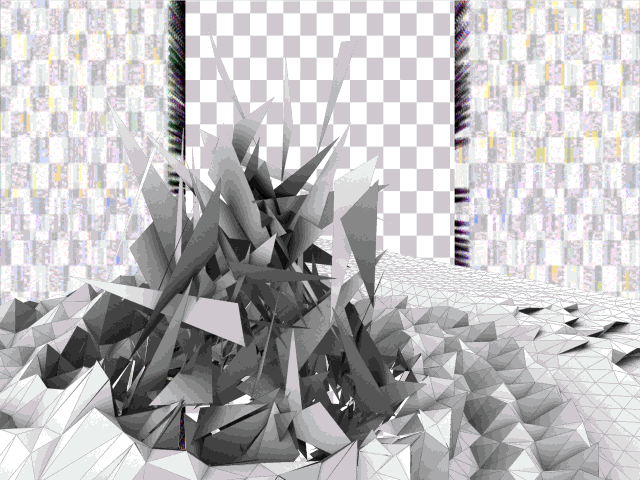Images courtesy of the artist
Caracas-based glitch and video artist Maggy Almao makes work that features an early Internet art and slightly cyberpunk vibe where visuals teeter on the verge of disintegration. She first got interested in digital art during her CGI studies at the ESRA Institute in Paris. When friends began talking about glitch art, she checked out Rosa Menkman’s cult-status Vernacular of File Formats and was hooked.
Videos by VICE
Almao’s first forays into the world of glitch were experimental. Initially, she corrupted image files in different formats with a text editor, then shared them with glitch groups. Soon she was corrupting other media, mostly video, before experimenting with GIFs.
The first of Almao’s video artwork to be exhibited, Don’t Feed The Data, was shown at S.P.A.M.M. SAFARI in 2013. It features fractalized shapes and animal forms (elephants, deer) flickering across a screen of colorfully-corrupted footage. Her latest videos, Dyauṣpitṛ, The Dataists, and Hᴧng_Shᴧᴎ_Shuɨ are more evolved, featuring 3D-rendered and animated topographical and geometric forms floating in seas of constantly shifting and dynamic glitch. (More on these videos below.)
For Almao, each new project is an experiment. She constantly runs “new tests,” and saves those she likes most. Expecting to be pulled in unexpected directions, Almao drifts down non-linear and “erratic” but always fun and exciting digital paths. Much of this work is done on Maya’s Autodesk, Apple’s Quartz Composer, and Audacity.
Almao uses Maya for 3D modeling, animation, and rendering, but also to apply complex textures to her work. She primarily uses Quartz Composer to inject corruption into video files or still images, which are often used as the files’ background.
“I’ve used other programs for this purpose in the past—the sound editing program Audacity, for instance—but I find Quartz Composer to be more versatile,” she said. “You can inject random noise into videos, and make them react to sound or perform video feedback, and Quartz Composer is a bit buggy itself, which makes it ideal for glitching. Finally, I use Adobe Premiere for compositing, and syncing the video with the soundtrack.”
Though Almao’s stills and videos’ disintegrate in wild fashion, conjuring William Gibson’s famous opening line in Neuromancer, “The sky above the port was the color of television, tuned to a dead channel,” Almao insists that any cyberpunk vibe is unintentional. There is no ideology or hidden messages in her videos.
“We are just more and more immersed in technology in our daily lives, and some of the techniques I use are based on misusing it,” Almao said. “I like simple, coarse aesthetics, and most of the time I use a limited palette of colors and I don’t bother much about rendering. Maybe in that regard there is a similarity with the early days of the internet, where computer graphics were simpler and more rudimentary.”
Almao created Dyauṣpitṛ (the name of Jupiter in Hindu myth) under a constraint. It had to be 28 seconds in length, a requirement for the Pixellin exhibition this September. Having always been interested in planets, Almao created textured black and white 3D spheres to suggest their shape. Then she forced them to “fall apart” using a particle system, and applied turbulence fields until the shapes became distorted.
Antoine Marroncles (Dafake Panda), a glitch and IDM producer, composed the soundtrack and frequent collaborator, used some electromagnetic fields sounds captured by the Voyager spacecraft as it drifted past Jupiter on its way out of the solar system. As a result, Dyauṣpitṛ’s rhythm is more smooth and almost musical in comparison to other work, though Almao incorporates light touches of optical art to give the video its distinct striped background.

Almao and Marroncles also collaborated on The Dataists, which Almao said has no central concept, but was instead a fun exercise in finding images that paired well with Marroncles’ sound design. Hᴧng_Shᴧᴎ_Shuɨ, on the other hand, features two feedback patches created in Quartz Composer—one shot by Almao on holiday in Portugal, which features people playing hang drum next to the Douro river in Porto, the other a moving surface animated in Maya.
“The result made me think of binary mountains, and I’ve not managed to get the same kind of distortion since,” Almao said. “I also datamoshed footage of the Seine River shore in Paris, applying sonification with Audacity. Among my videos, this is the one that includes the most techniques, like a binary collage or recycling footage.”
Almao’s GIF work, on the other hand, is meant to be irreverent. She sees it as a friendly and practical format, allowing the artist to link still images and videos. And she digs that a moment can be captured in a few frames, and then run indefinitely without clicking “play.” The newer, higher resolution and more lightweight format GFY isn’t as appealing to Almao, as she finds GIF’s jerky movements more satisfying.
The recent Pᴧrticɭɘs GIF series grew out of Almao’s 3D landscape work in Maya. “I made it explode, applying different fields on the broken pieces, until their movement was interesting,” she said. “For the background, I made a Quartz Composer patch using video feedback from the built-in camera. I really like using feedback, either from footage or from the cam. You have plenty of parameters to tune, and you can get totally unexpected results.”
In Almao’s digital world, her strength may be that everything feels spontaneous in a neat way—a break from the often overly-calculated or heavily conceptual projects that also occupy this terrain. For her, it is the unexpected, the non-linear detours that perhaps matter most, giving her art a nice fresh breath of disintegration.
Currently, Almao is at work on a video called Dialogue Paradoxal, in which she’s attempting to recreate “the evolution of a digital nightmare” by layering 3D-modeled heads which become distorted in response to sound. Dialogue Paradoxal will appear in the Onirical Room portion of the Colectivo Fluidos exhibition in Caracas, Venezuela at the National Art Gallery this October.
And for more of her work, visit her website here: www.maggyalmao.com
Related:
Why Are We So Obsessed With Editing Photos Beyond Reality?
Here’s What Artificially Intelligent Pixel Bending Looks Like



